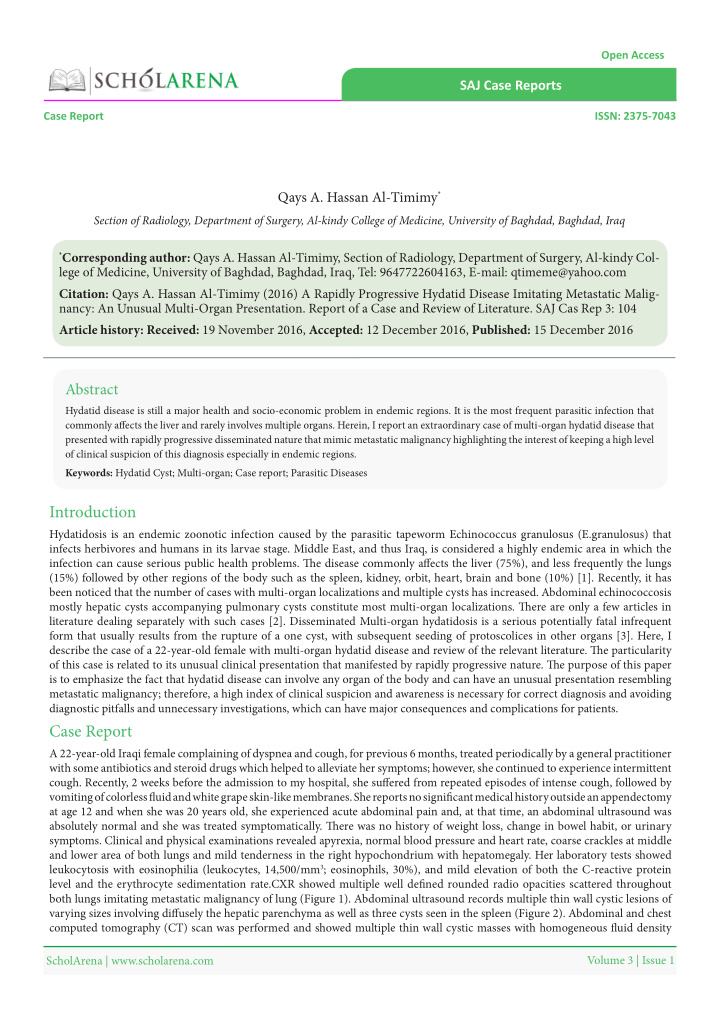



Open Access SAJ Case Reports Case Report ISSN: 2375-7043 A Rapidly Progressive Hydatid Disease Imitating Metastatic Malignancy: An Unusual Multi-Organ Presentation. Report of a Case and Review of Literature Qays A. Hassan Al-Timimy * Section of Radiology, Department of Surgery, Al-kindy College of Medicine, University of Baghdad, Baghdad, Iraq * Corresponding author: Qays A. Hassan Al-Timimy, Section of Radiology, Department of Surgery, Al-kindy Col- lege of Medicine, University of Baghdad, Baghdad, Iraq, Tel: 9647722604163, E-mail: qtimeme@yahoo.com Citation: Qays A. Hassan Al-Timimy (2016) A Rapidly Progressive Hydatid Disease Imitating Metastatic Malig- nancy: An Unusual Multi-Organ Presentation. Report of a Case and Review of Literature. SAJ Cas Rep 3: 104 Article history: Received: 19 November 2016, Accepted: 12 December 2016, Published: 15 December 2016 Abstract Hydatid disease is still a major health and socio-economic problem in endemic regions. It is the most frequent parasitic infection that commonly afgects the liver and rarely involves multiple organs. Herein, I report an extraordinary case of multi-organ hydatid disease that presented with rapidly progressive disseminated nature that mimic metastatic malignancy highlighting the interest of keeping a high level of clinical suspicion of this diagnosis especially in endemic regions. Keywords: Hydatid Cyst; Multi-organ; Case report; Parasitic Diseases Introduction Hydatidosis is an endemic zoonotic infection caused by the parasitic tapeworm Echinococcus granulosus (E.granulosus) that infects herbivores and humans in its larvae stage. Middle East, and thus Iraq, is considered a highly endemic area in which the infection can cause serious public health problems. Tie disease commonly afgects the liver (75%), and less frequently the lungs (15%) followed by other regions of the body such as the spleen, kidney, orbit, heart, brain and bone (10%) [1]. Recently, it has been noticed that the number of cases with multi-organ localizations and multiple cysts has increased. Abdominal echinococcosis mostly hepatic cysts accompanying pulmonary cysts constitute most multi-organ localizations. Tiere are only a few articles in literature dealing separately with such cases [2]. Disseminated Multi-organ hydatidosis is a serious potentially fatal infrequent form that usually results from the rupture of a one cyst, with subsequent seeding of protoscolices in other organs [3]. Here, I describe the case of a 22-year-old female with multi-organ hydatid disease and review of the relevant literature. Tie particularity of this case is related to its unusual clinical presentation that manifested by rapidly progressive nature. Tie purpose of this paper is to emphasize the fact that hydatid disease can involve any organ of the body and can have an unusual presentation resembling metastatic malignancy; therefore, a high index of clinical suspicion and awareness is necessary for correct diagnosis and avoiding diagnostic pitfalls and unnecessary investigations, which can have major consequences and complications for patients. Case Report A 22-year-old Iraqi female complaining of dyspnea and cough, for previous 6 months, treated periodically by a general practitioner with some antibiotics and steroid drugs which helped to alleviate her symptoms; however, she continued to experience intermittent cough. Recently, 2 weeks before the admission to my hospital, she sufgered from repeated episodes of intense cough, followed by vomiting of colorless fmuid and white grape skin-like membranes. She reports no signifjcant medical history outside an appendectomy at age 12 and when she was 20 years old, she experienced acute abdominal pain and, at that time, an abdominal ultrasound was absolutely normal and she was treated symptomatically. Tiere was no history of weight loss, change in bowel habit, or urinary symptoms. Clinical and physical examinations revealed apyrexia, normal blood pressure and heart rate, coarse crackles at middle and lower area of both lungs and mild tenderness in the right hypochondrium with hepatomegaly. Her laboratory tests showed leukocytosis with eosinophilia (leukocytes, 14,500/mm 3 ; eosinophils, 30%), and mild elevation of both the C-reactive protein level and the erythrocyte sedimentation rate.CXR showed multiple well defjned rounded radio opacities scattered throughout both lungs imitating metastatic malignancy of lung (Figure 1). Abdominal ultrasound records multiple thin wall cystic lesions of varying sizes involving difgusely the hepatic parenchyma as well as three cysts seen in the spleen (Figure 2). Abdominal and chest computed tomography (CT) scan was performed and showed multiple thin wall cystic masses with homogeneous fmuid density ScholArena | www.scholarena.com Volume 3 | Issue 1
2 SAJ Case Rep contains in the liver, lungs and spleen (Figure 3). Some cysts show detached membrane and daughter vesicles within. Tiese imaging fjndings were generally suffjcient for diagnosis of hydatid disease. Although, the patient reports no contact with sheep or dogs at home or at work. She was university student and lives in an urban area in Baghdad with her family. Afuer imaging procedures, she was hospitalized. Serologic test results for echinococcus by means of an indirect haemagglutination test were positive. Tien, the diagnosis of hydatid disease was confjrmed, and chemotherapy was decided. My patient was treated with oral albendazole (400 mg twice daily) in association with praziquentel 50 mg/kg per day during 15 days. She was discharged afuer two weeks hospital stay with a good general health state and she will be maintained on albendazole with regular follow-up. Figure 1: Chest X-ray showing multiple nodular opacities in both lungs resembling metastasis Figure 2: (A) Image from the liver ultrasound shows inummerable cysts of varyig sizes; and (B) Image from the spleen ultrasound demonstrate three cysts Figure 3: (A-D) Chest CT scan in lung window shows multiple lesions scattered through bilateral pulmonary parenchyma with some containing detached membranes indicating ruptured hydatids; (E,F) Chest and abdominal CT scan in sofu tissue window shows a multiple cystic lesions in the lung, liver and spleen Discussion Hydatid disease is a parasitic infection caused by E. granulosus that represents a major public health problem in many countries including Middle East [4,5]. Its main hosts are dogs and foxes and its intermediate hosts are herbivores. Humans become infected ScholArena | www.scholarena.com Volume 3 | Issue 1
Recommend
More recommend